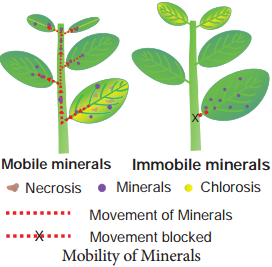Learninsta presents the core concepts of Biology with high-quality research papers and topical review articles.
Classification of Minerals
Classification of Minerals Based on Their Quantity Requirements
Essential elements are classified as Macro-nutrients, Micronutrients and Unclassified minerals based on their requirements. Essential minerals which are required in higher concentration are called Macronutrients. Essential minerals which are required in less concentration called are as Micronutrients.
Minerals like Sodium, Silicon, Cobalt and Selenium are not included in the list of essential nutrients but are required by some plants, these minerals are placed in the list of unclassified minerals. These minerals play specific roles for example, Silicon is essential for pest resistance, prevent water lodging and aids cell wall formation in Equisetaceae (Equisetum), Cyperaceae and Gramineae (Table 12. 1).
|
Macro Nutrients |
Micro Nutrients |
Unclassified Minerals |
| Excess than 10 mmole Kg-1 in tissue concentration or 0.1 to 10 mg per gram of dry weight | Less than 10 mmole Kg-1 in tissue concentration or equal or less than 0.1 mg per gram of dry weight | Required for some plants in trace amounts and have some specific functions |
| Example: C, H, O, N, P, K, Ca, Mg and S | Example: Fe, Mn, Cu, Mo, Zn, B, Cl and N | Example: Sodium, Cobalt, Silicon and Selenium |
Classification of Minerals Based on Mobility
If you observe where the deficiency symptoms appear first, you can notice differences in old and younger leaves. It is mainly due to mobility of minerals. Based on this, they are classified into:-
- Actively mobile minerals and
- Relatively immobile minerals (Figure 12.1).
|
Macro Nutrients |
Micro Nutrients |
Unclassified Minerals |
| Excess than 10 mmole Kg-1 in tissue concentration or 0.1 to 10 mg per gram of dry weight | Less than 10 mmole Kg-1 in tissue concentration or equal or less than 0.1 mg per gram of dry weight | Required for some plants in trace amounts and have some specific functions |
| Example: C, H, O, N, P, K, Ca, Mg and S | Example: Fe, Mn, Cu, Mo, Zn, B, Cl and N | Example: Sodium, Cobalt, Silicon and Selenium |
Actively Mobile Minerals
Nitrogen, Phosphorus, Potassium, Magnesium, Chlorine, Sodium, Zinc and Molybdenum. Deficiency symptoms first appear on old and senescent leaves due to active movement of minerals to younger leaves.
Relatively Immobile Minerals
Calcium, Sulphur, Iron, Boron and Copper shows deficiency symptoms first that appear on young leaves due to the immobile nature of minerals.

Classification of Minerals Based on their Functions
Structural Component Minerals:
Minerals like Carbon, Hydrogen, Oxygen and Nitrogen
Enzyme Function:
Molybdenum (Mo) is essential for nitrogenase enzyme during reduction of atmospheric nitrogen into ammonia. Zinc (Zn) is an important activator for alcohol dehydrogenase and carbonic anhydrase. Magnesium (Mg) is the activator for RUBP carboxylaseoxygenase and PEP carboxylase. Nickel (Ni) is a constituent of urease and hydrogenase.
Osmotic Potential:
Potassium (K) plays a key role in maintaining osmotic potential of the cell. The absorption of water, movement of stomata and turgidity are due to osmotic potential.
Energy Components:
Magnesium (Mg) in chlorophyll and phosphorous (P) in ATP.